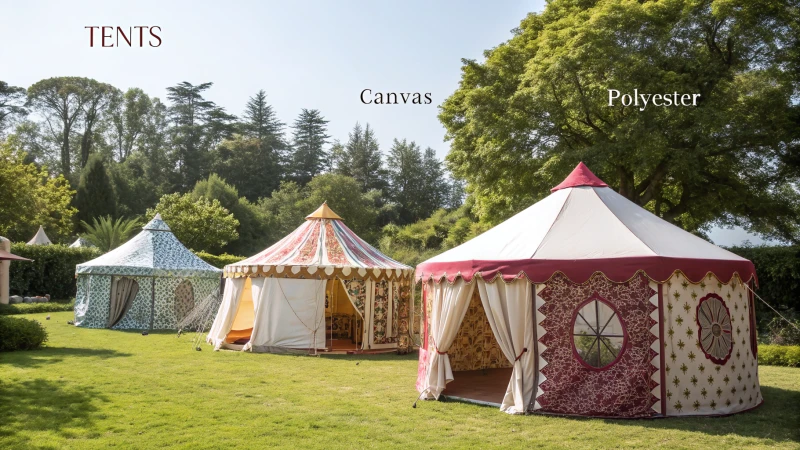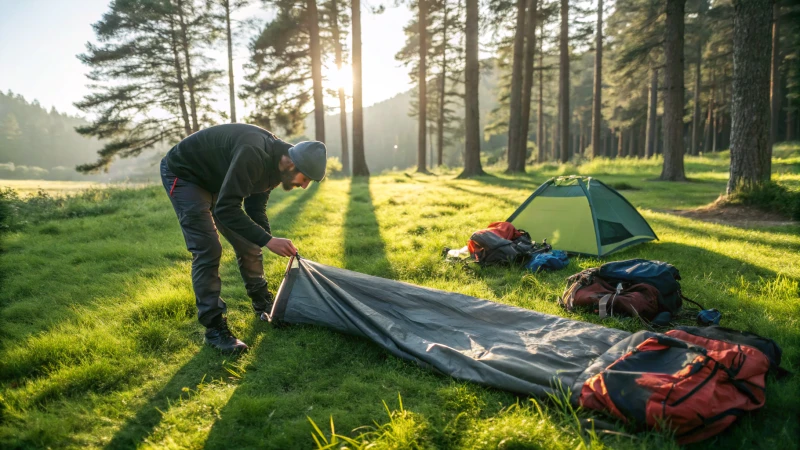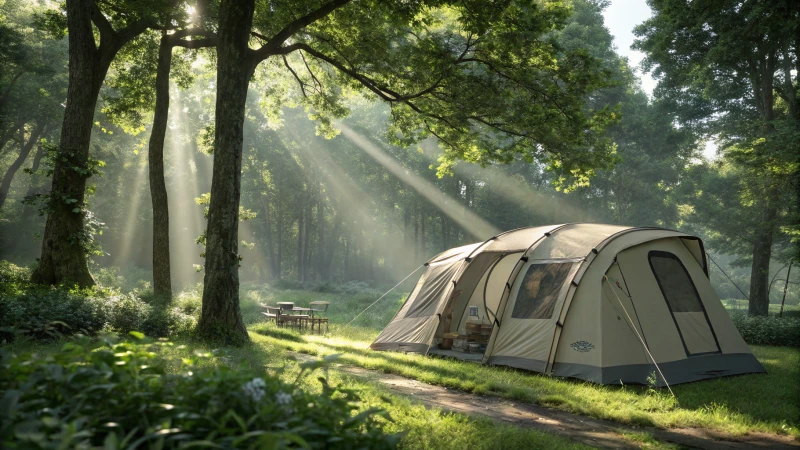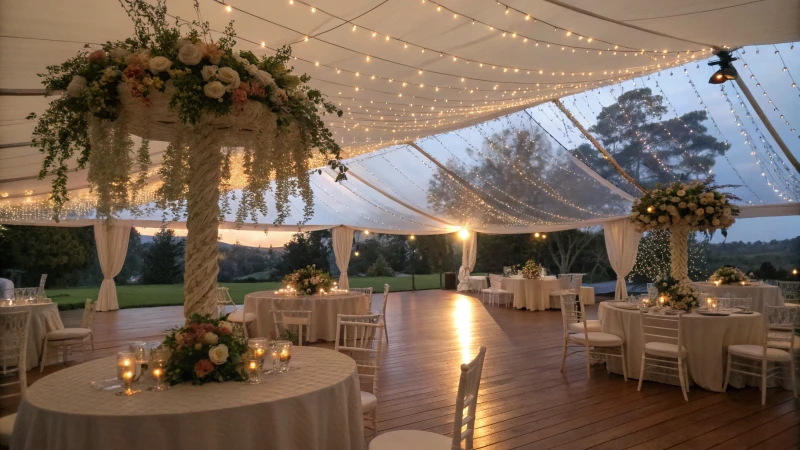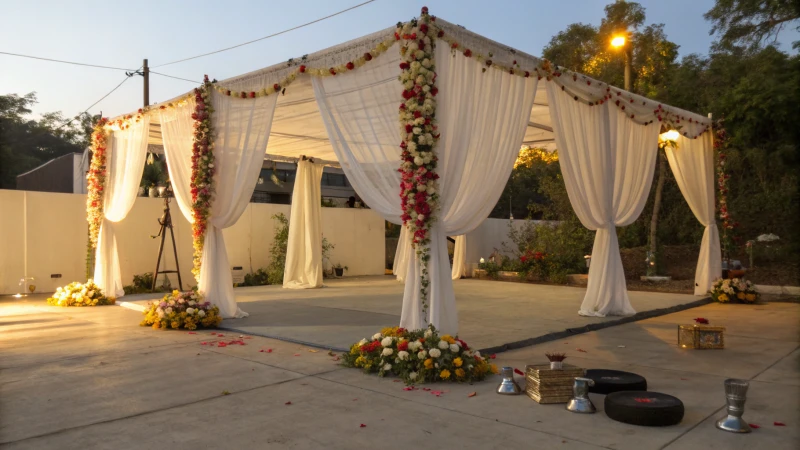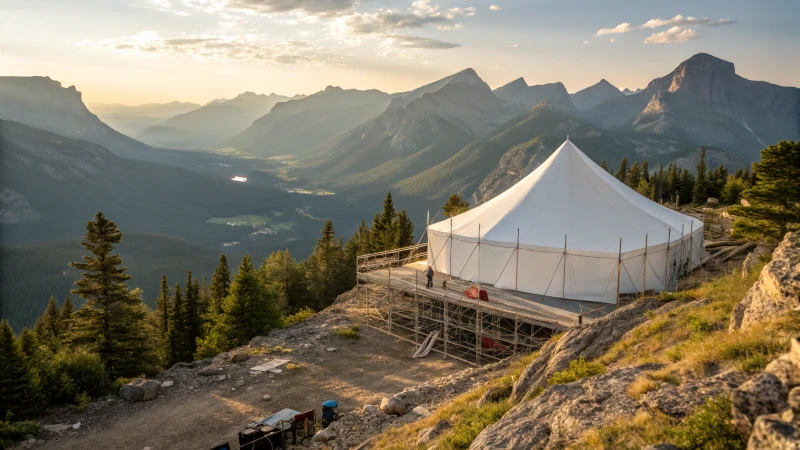
Have you ever found yourself enchanted by the idea of hosting an event amidst mountain peaks, only to wonder how on earth you’d set up a marquee there?
To successfully set up a large event marquee on a mountain, start by thoroughly surveying the terrain to pinpoint safety hazards and identify a suitable site. Scaffolding platforms help level the ground, while modular components ensure easy transportation and installation.
When I first considered setting up a marquee in such a breathtaking location, my excitement was matched by concern over the logistics. You see, mountains bring their own set of challenges—uneven ground, unpredictable weather, and sometimes tricky access routes. But it’s all part of the adventure, isn’t it?
The initial task is all about understanding the land. Walking the terrain, feeling the unevenness underfoot, and picturing where your guests will mingle is essential. This step is like laying the foundation of a house—it’s crucial. Once you’ve mapped out potential hazards and chosen your spot, scaffolding platforms become your best friends. These platforms are like the unsung heroes that create a stable base for your marquee, despite the natural imperfections of the mountain.
Transporting all the parts can feel like a puzzle. That’s where modular components come in handy. Their design makes them easy to transport, even if you’re navigating narrow, winding paths. Assembling them feels almost therapeutic, knowing each piece is crucial to creating a space where memories will be made.
For anyone daunted by the idea of setting up a marquee in such an environment, remember that with the right preparation and tools, it’s not just possible—it’s incredibly rewarding. And trust me, when you see that final view with your marquee standing proud against the mountain backdrop, every effort feels worth it.
Marquees on mountains require scaffolding for stability.True
Scaffolding is used to level uneven ground, ensuring marquee stability.
Mountain marquees don't need terrain surveys before setup.False
Surveying identifies hazards and suitable sites, crucial for safety.
What Terrain Considerations Are Essential for Mountainous Marquee Setup?
Imagine orchestrating a breathtaking event amidst the grandeur of mountains. It sounds dreamy, but it comes with its own set of challenges.
To set up a marquee in mountainous areas, focus on ground stability, manage slope variations, ensure easy access, and prepare for unpredictable weather. These steps are crucial for a safe and successful event.
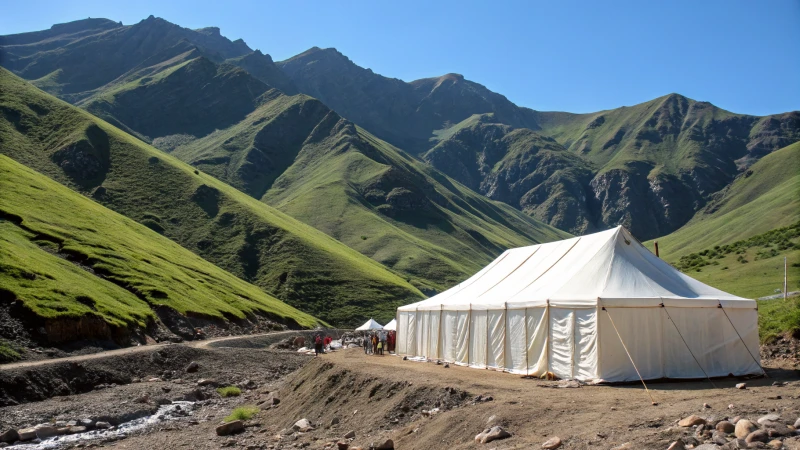
Assessing Ground Stability
Understanding the stability of the ground is the first step in planning a mountainous marquee setup1. Uneven or loose soil can pose significant risks. Conducting a thorough survey to determine soil firmness and identifying any potential hazards like rocks or tree roots is crucial. This information helps in deciding whether additional groundwork or reinforcement is required.
Managing Slope Variations
Slopes present a challenge in marquee installations. It’s important to evaluate the gradient and decide if leveling measures or scaffold platforms are needed. Platforms can provide a stable base, allowing the marquee to maintain its structural integrity. It’s vital to ensure that these solutions comply with safety standards to prevent accidents.
Ensuring Accessibility
Access can be limited in mountainous regions, affecting transportation of materials and personnel. Consider modular designs2 that can be easily transported and assembled on-site. This approach minimizes logistical challenges and reduces transportation costs. Moreover, planning access routes that accommodate essential vehicles is imperative for efficient setup.
| Factor | Consideration |
|---|---|
| Soil Type | Stability assessment and reinforcement needs |
| Gradient | Slope management through platforms |
| Access | Modular components and transport logistics |
Accounting for Weather Conditions
Mountainous areas often have unpredictable weather, which can impact marquee stability. Wind resistance is a primary concern. Choosing materials and designs that withstand high winds and fluctuating temperatures is crucial. Implementing effective anchoring systems will help secure the structure against adverse weather.
Incorporating these considerations into the planning phase ensures not only the safety3 but also the functional success of your event under challenging conditions.
Uneven soil poses no risk to marquee setups.False
Uneven soil can destabilize marquees, risking collapse or damage.
Platforms help stabilize marquees on slopes.True
Platforms provide a level base, maintaining structural integrity.
How Can Modular Design Facilitate Mountainous Marquee Installation?
Imagine setting up a grand event tent in the mountains—sounds challenging, right? Let me show you how modular design can make it surprisingly simple.
Modular design simplifies mountainous marquee installation by using prefabricated parts, which are easy to transport and assemble. This method reduces the need for specialized tools, cuts costs, and adapts well to uneven terrains.
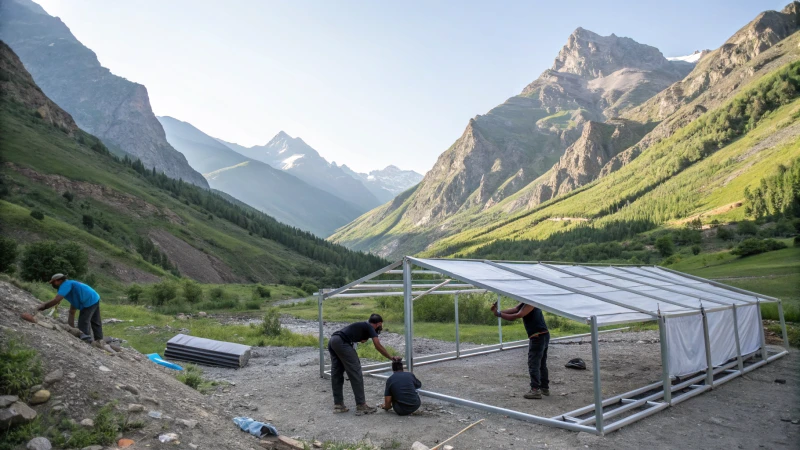
Modular Design Basics
Let me tell you, the beauty of modular design is in its simplicity and adaptability. It’s like having a puzzle where each piece fits perfectly, making the whole picture come together effortlessly. This approach is a lifesaver in mountainous terrains where the ground is as unpredictable as the weather. With prefabricated sections, there’s no need for on-site cutting or welding—everything just snaps into place.
Modular design involves creating structures using pre-made components, allowing for quick assembly and disassembly. This method is particularly beneficial in mountainous areas where terrain unevenness4 presents unique challenges.
Transportation Advantages
Transporting large marquees through narrow mountain paths used to be my worst nightmare. But with modular design, the parts can be broken down into smaller, manageable pieces. I remember one project where we had to navigate some seriously winding roads, and being able to load components onto smaller vehicles saved us a ton of stress—and money!
Transporting large marquees to mountainous areas can be problematic due to narrow roads and rugged paths. However, modular components can be broken down into smaller pieces, easily transported via smaller vehicles. This adaptability not only reduces transportation5 costs but also minimizes logistical complications.
| Feature | Benefit |
|---|---|
| Prefabrication | Reduces on-site labor and time |
| Smaller Components | Easier transport through narrow paths |
| No On-Site Welding | Decreases installation complexity |
Flexibility in Design
One of the things I love most about modular structures is their flexibility. Each event is unique, and so is the site. With modular design, I can customize the marquee’s size and shape to fit snugly into any space, no matter how uneven the ground is. It’s like tailoring a suit—everything fits just right.
Modular structures offer flexibility, allowing event planners to tailor marquee size and shape to specific site requirements. This customization is vital in mountainous areas where space is constrained, and site6 conditions vary significantly.
Cost Efficiency
Operating in remote areas can drive costs sky-high, especially when heavy machinery is involved. But with modular units, I’ve found that we can keep expenses down while delivering top-notch quality. This approach appeals to anyone looking for competitive pricing without cutting corners on quality.
Employing a modular design reduces the need for heavy machinery or extensive labor, which can drive up costs in remote locations. By optimizing the use of pre-fabricated units, companies can provide cost-effective solutions while maintaining high-quality standards.
This approach can be especially appealing to businesses seeking competitive pricing7 without sacrificing quality.
Enhancing Adaptability
Adapting to different terrains quickly is another perk of modular design. On one occasion, we had to install a marquee on a slope that seemed impossible at first glance. Thanks to modular components, we managed to create a stable and safe structure that met all our needs aesthetically and functionally.
The ability to quickly adapt marquee installations to varying terrains is a significant advantage of modular design.
Modular design eliminates the need for on-site welding.True
Prefabricated components remove the necessity for welding during installation.
Modular design increases transportation costs in mountainous areas.False
Smaller components reduce transportation costs by allowing easier access.
What Are the Transportation Challenges and Solutions for Mountain Locations?
Navigating the rugged beauty of mountain regions can be as challenging as it is breathtaking. Ever wondered how we conquer these natural obstacles to ensure smooth transportation?
Transportation in mountainous areas is challenged by steep slopes, narrow roads, and harsh weather, but solutions like specialized vehicles, improved infrastructure, and advanced GPS technology help overcome these obstacles.
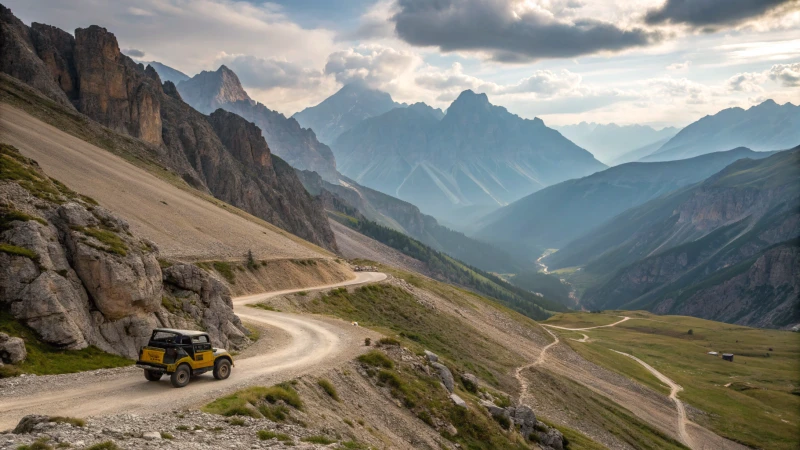
The Unique Terrain Challenges
Living in or near mountainous regions, I’ve seen firsthand how these landscapes can pose unique transportation hurdles. Imagine trying to navigate steep gradients or winding roads that seem to disappear under landslides. Once, I recall a trip where a sudden rockfall blocked our path, turning what was supposed to be a quick drive into an overnight adventure. The unpredictable weather adds another layer of complexity, with snow and rain frequently altering the terrain.
Innovative Vehicle Design
To tackle these challenges, we need more than just regular vehicles. Think about those moments when you need that extra grip or power to conquer a steep slope. That’s where specialized vehicles come into play. All-wheel drives and high-torque engines are game-changers. I once saw a demonstration of specialized transport vehicles8 designed specifically for these terrains, and it was impressive how they glided over obstacles with ease.
Infrastructure Improvement Strategies
Improving road infrastructure is like laying down a safety net for travelers in mountain areas. Engineers often get creative—constructing tunnels or bridges to bypass the trickiest sections. I’ve always marveled at the skill and thoughtfulness that go into building these structures. Retaining walls, for instance, are not just about holding back the earth; they’re about ensuring peace of mind for everyone using those roads.
| Strategy | Benefit |
|---|---|
| Tunnels and Bridges | Avoid dangerous terrain |
| Retaining Walls | Prevent landslides |
| Wider Roads | Accommodate larger vehicles safely |
The Role of Technology
In today’s world, technology is our trusty sidekick in tackling transportation challenges. GPS technology has revolutionized navigation, offering real-time updates that can guide us through even the most treacherous paths. I’m excited about the potential of autonomous vehicles in mountainous areas9 because they promise to minimize human error and enhance safety.
Ultimately, overcoming mountain transportation hurdles requires a blend of innovative vehicle designs, smart infrastructure upgrades, and cutting-edge technology to ensure safe and efficient journeys through these majestic landscapes.
Specialized vehicles improve mountain transportation.True
All-wheel-drive systems and high-torque engines help navigate steep slopes.
Wider roads increase landslide risks in mountains.False
Wider roads accommodate larger vehicles safely, reducing congestion risks.
How can I ensure my marquee is safe and stable on uneven ground?
Imagine planning your dream outdoor event, only to realize the ground is as uneven as life’s challenges. Here’s how you can still make it happen.
To stabilize a marquee on uneven ground, start by surveying the site and using leveling tools. Employ adjustable base plates, weighted anchors, and tensioning devices to secure the structure. Ensure proper drainage and consider hiring professionals for complex terrains.
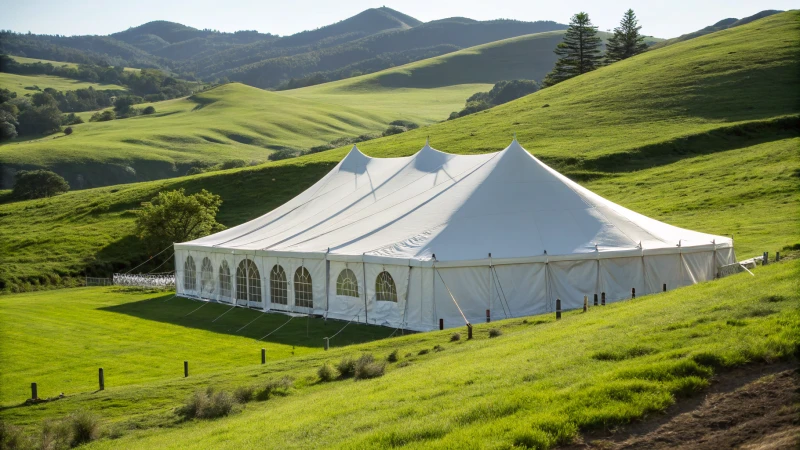
Survey and Preparation
I remember when I first attempted to set up a marquee on a slope. It felt like trying to balance a teetering stack of books. The key lesson? Conduct a thorough site survey before doing anything else. Identify dips, slopes, or any lurking hazards. Laser levels or transit levels become your best friends here, allowing you to measure elevation differences with precision. Document everything—it’s like creating a battle plan, tackling each challenge head-on.
Choosing the Right Equipment
The first time I heard about adjustable base plates, it was a game changer. These aren’t just fancy terms; they’re lifesavers for ensuring your marquee doesn’t resemble a crooked tower of Pisa. They let you adjust for height variations, laying a solid foundation for your structure. Then come the weighted anchors—think of them as your marquee’s best defenders against unruly winds. Water barrels or concrete blocks do wonders. And don’t forget tensioning devices like ratchet straps; they’re like adding extra seatbelts for safety.
| Equipment Needed | Purpose |
|---|---|
| Adjustable Plates | Leveling and stabilization |
| Weighted Anchors | Enhanced structural security |
| Tension Devices | Reinforcement against movement |
Addressing Drainage Issues
I’ve learned the hard way that poor drainage can quickly turn your event into an impromptu swimming pool party. Creating effective drainage solutions10 like trenches or utilizing waterproof flooring systems can save the day. Keeping water at bay is crucial for maintaining stability.
Professional Assistance
Sometimes, the terrain is just too tricky to tackle alone. Hiring professionals specializing in marquee installation11 on uneven grounds might just be the peace of mind you need. Their expertise can transform what seems impossible into a seamless setup.
Modular Design Benefits
I’ve always appreciated the modular design’s simplicity—like piecing together a puzzle without any missing pieces. Modular marquees not only simplify transport and logistics but also reduce setup complexity on uneven terrain. They’re a cost-effective solution for large events, saving time and hassle.
- Advantages of Modular Systems:
- Simplifies transport and logistics.
- Reduces setup complexity on uneven terrain.
- Cost-effective solution for large events.
By adopting these practices, you’re not just setting up a marquee; you’re ensuring it stands strong against nature’s unpredictability. Embrace thorough planning, proper equipment, and expert advice to guarantee your event’s success—even on the most challenging grounds.
Adjustable plates are essential for leveling a marquee.True
Adjustable plates help stabilize and level marquees on uneven surfaces.
Weighted anchors are unnecessary for marquee stability.False
Weighted anchors enhance structural security, crucial on uneven ground.
Conclusion
Setting up a large event marquee on mountains requires careful terrain assessment, scaffolding for stability, modular designs for transport, and weather considerations to ensure a successful event.
-
Learn techniques to assess ground stability, crucial for safe tent setups in uneven terrains. ↩
-
Explore how modular designs ease transport and setup in remote locations. ↩
-
Discover effective anchoring systems that enhance tent stability in adverse weather conditions. ↩
-
Understanding how modular design manages uneven terrain can help you apply these principles effectively in challenging locations. ↩
-
Learn how modular components simplify transportation challenges, particularly in remote or difficult-to-access locations. ↩
-
Explore how customizable designs allow modular structures to fit diverse site conditions efficiently. ↩
-
Discover the financial advantages of using modular construction methods to optimize budget without compromising quality. ↩
-
Learn about vehicles designed for mountain terrains that offer better stability and traction. ↩
-
Explore how autonomous technology is improving safety in mountain transport. ↩
-
Learn about creating effective drainage systems to prevent water damage and maintain marquee stability. ↩
-
Discover services that provide expert installation of marquees on challenging terrains. ↩


